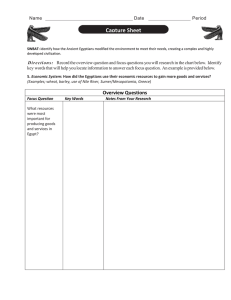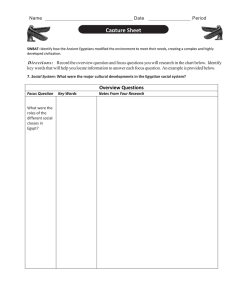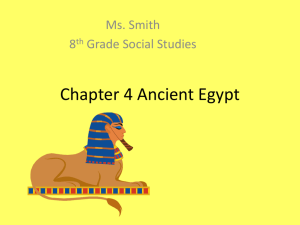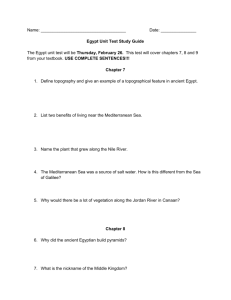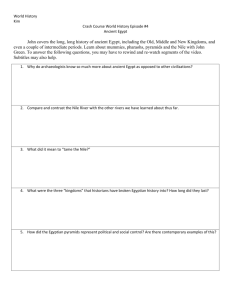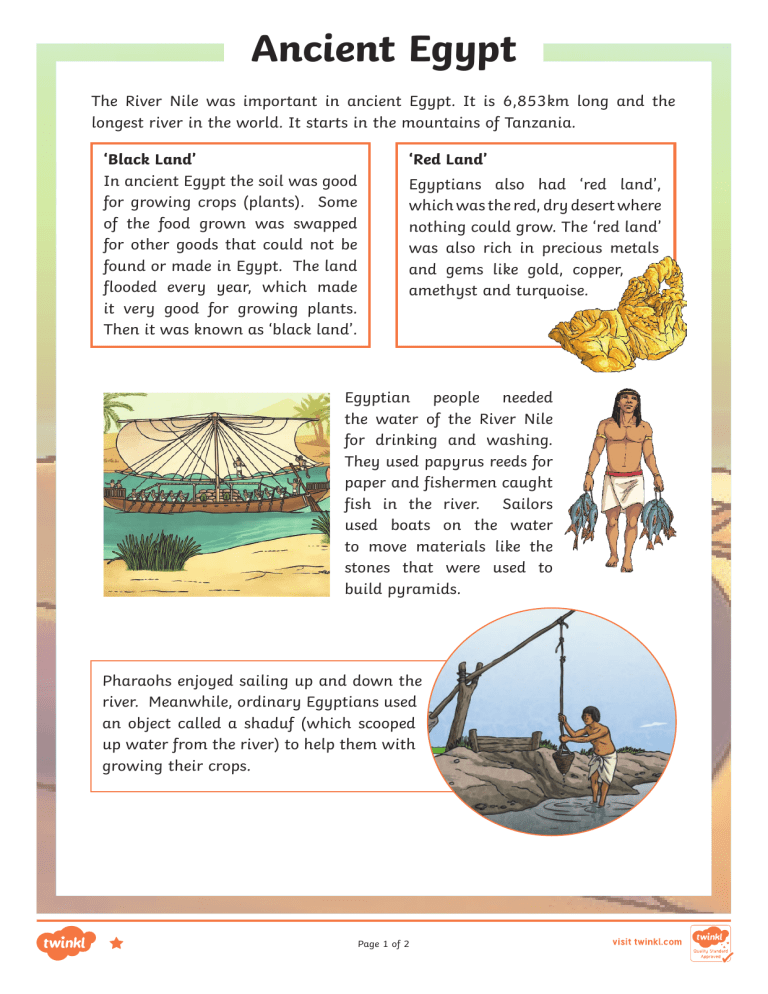
Ancient Egypt The River Nile was important in ancient Egypt. It is 6,853km long and the longest river in the world. It starts in the mountains of Tanzania. ‘Black Land’ In ancient Egypt the soil was good for growing crops (plants). Some of the food grown was swapped for other goods that could not be found or made in Egypt. The land flooded every year, which made it very good for growing plants. Then it was known as ‘black land’. ‘Red Land’ Egyptians also had ‘red land’, which was the red, dry desert where nothing could grow. The ‘red land’ was also rich in precious metals and gems like gold, copper, amethyst and turquoise. Egyptian people needed the water of the River Nile for drinking and washing. They used papyrus reeds for paper and fishermen caught fish in the river. Sailors used boats on the water to move materials like the stones that were used to build pyramids. Pharaohs enjoyed sailing up and down the river. Meanwhile, ordinary Egyptians used an object called a shaduf (which scooped up water from the river) to help them with growing their crops. Page 1 of 2 Questions 1. How long was the River Nile? 2. Where does the river start? 3. Which colour was the desert land? 4. Who moved stones on the water? 5. Why do you think rivers are so important? 6. Name two precious metals found in Egypt: 7. What is a shaduf? Page 2 of 2 Ancient Egypt Answers Ancient Egypt 1. How long was the River Nile? 6.853km long. 2. Where does the river start? It starts in the mountains of Tanzania. 3. Which colour was the desert land? The desert land was red. 4. Who moved stones on the water? Sailors used boats on the water to move materials like stones. 5. Why do you think rivers are so important? Egyptians used the water to drink, for washing, to grow their crops, for fishing. 6. Name two precious metals found in Egypt: Gold and copper. 7. What is a shaduf? An object which scoops up water from the river. Page 1 of 1 Ancient Egypt Important to survival in ancient Egypt was the River Nile. At 6,853km long, it is the longest river in the world, starting in the mountains of Tanzania and flowing through most of north-eastern Africa. ‘Black Land’ In ancient times its soil was rich for growing crops, which fed and clothed the people who lived along the banks of the Nile. Some of the food grown was also swapped for other goods that could not be found or made in Egypt. The land flooded every year, leaving thick, black sand on the ground, which made it very good for growing plants. This was known as the ‘black land’. ‘Red Land’ Egyptians also had ‘red land’, which was the red, dry desert where nothing could grow. It protected the people of ancient Egypt from enemies because it was so difficult for invading armies to cross. The ‘red land’ was also full of precious metals and gems such as gold, copper, granite, limestone, amethyst, alabaster and turquoise. Egyptian people relied on the water of the River Nile for drinking and washing. A useful crop living along the banks of the river was papyrus reeds. They were dried and used to make a type of paper. Travelling along the river were traders (people who sold goods), fishermen and sailors, moving materials such as stones for building pyramids. Pharaohs enjoyed cruising up and down the river. Meanwhile, ordinary Egyptians created different ways of using the river water as much as possible. One important invention was the shaduf. This was designed to scoop water from the river and move it so that it could be sprinkled on the land where crops were growing. Page 1 of 2 Questions Ancient Egypt 1. How long was the River Nile? 2. What does the author mean by the word ‘flowing’? 3. If you could choose to live in the ‘black land’ or the ‘red land’, which area would you choose to live in and why? 4. Why do you think rivers are so important to people’s live? 5. Name two precious metals found in Egypt. 6. What is a shaduf? Page 2 of 2 Answers Ancient Egypt 1. How long was the River Nile? It is 6.853km long. 2. What does the author mean by the word ‘flowing’? The author means moving steadily 3. If you could choose to live in the ‘black land’ or the ‘red land’, which area would you choose to live in and why? Various answers possible. 4. Why do you think rivers are so important to people’s live? Rivers bring water to people. Water is essential for humans, animals and plants to survive. 5. Name two precious metals found in Egypt. Copper and gold. 6. What is a shaduf? A shaduf is an object designed to scoop water from the river and move it so it could be sprinkled on the land where crops were growing. Page 1 of 1 Ancient Egypt Crucial to survival in ancient Egypt, was the River Nile. At 6853km long, it is the longest river in the world, starting in the mountains of Tanzania and flowing through most of north-eastern Africa. ‘Black Land’ In ancient times, its fertile soil provided rich nutrients for growing crops, which fed and clothed the people who lived along the banks of the Nile. Some of the food grown was also traded for other goods. The land flooded every year, leaving a thick, black silt on the ground, which made the ground very good for growing plants. This was known as ‘black land’. ‘Red Land’ Away from the river, Egyptians also needed its ‘red land’, which was the red, dry desert where nothing could grow. It protected the people of ancient Egypt because it separated the country from neighbouring countries and invading armies. The ‘red land’ was also rich in precious metals and gems such as gold, copper, granite, limestone, amethyst, alabaster and turquoise. Egyptian people relied on the water of the River Nile for drinking and washing. A useful crop that grew along the banks of the river was papyrus reeds. They were dried and used to make a type of paper. Travelling along the river were traders, transporting items to other areas, fishermen, looking for a healthy catch and sailors moving materials such as stones for building pyramids. Pharaohs enjoyed cruising up and down the river in luxury, relaxing in custom built vessels. Meanwhile, ordinary Egyptians created inventive ways of using the river water as extensively as possible. One important invention, still used widely today, was the shaduf. This was designed to scoop water from the river and move it so that it could be sprinkled on the land where crops were growing. Page 1 of 2 Questions Ancient Egypt 1. What does the author mean by “fertile soil”? 2. If you could choose to live in the ‘black land’ or the ‘red land’, which area would you choose to live in and why? 3. Why do you think so many Egyptian people lived so close to the banks of the river? 4. Why do you think the Egyptians needed to defend themselves from enemies? 5. Why is it important to know about the role of the River Nile in ancient Egyptian life? Page 2 of 2 Answers Ancient Egypt 1. What does the author mean by “fertile soil”? It is a soil capable of growing crops. 2. If you could choose to live in the ‘black land’ or the ‘red land’, which area would you choose to live in and why? Various answers 3. Why do you think so many Egyptian people lived so close to the banks of the river? Egyptian people relied on the water of the River Nile for drinking and washing. A useful crop that grew along the banks of the river was papyrus reeds. They were dried and used to make a type of paper. Travelling along the river were traders, transporting items to other areas, fishermen, looking for a healthy catch and sailors moving materials such as stones for building pyramids. 4. Why do you think the Egyptians needed to defend themselves from enemies? All ancient civilisations lived under the threat of invasion from rival civilisations. 5. Why is it important to know about the role of the River Nile in ancient Egyptian life? It is important to understand how and why ancient civilisations came to exist, thrive and deteriorate in order to understand people in the past. Page 1 of 1
